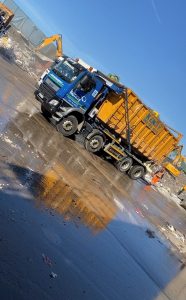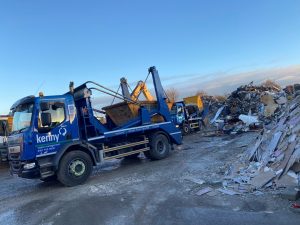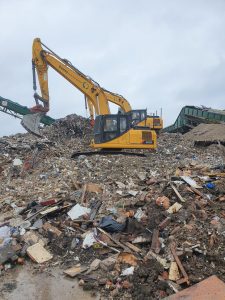Here at our state-of-the-art waste processing facility in Salford, we have a wide range of vehicles arriving on site, from our own skip and bin trucks to third party vehicles, ejector trailers, walking floors and tippers. With such a high volume of vehicles arriving and leaving the site daily, it is imperative that the facility is organised at all times. To help facilitate this, Kenny Waste Management provide specific in-house training to our on-site Banksmen.
When vehicles first arrive on site, they are safely directed to our regularly calibrated weighbridge, where their weight is taken and logged into our system. These weights can be easily communicated to our Banksmen and Waste Compliance officer via a radio system where needed. All relevant people at our facility are issued with a radio. Unlike mobile phones, our radio system can be relied upon at all times. Our radios are battery powered and don’t rely on any external signals when communicating. This ensures regular communication amongst site staff and enables us to meet our high health and safety standards.

After leaving the weighbridge, vehicles are waved through to the tipping area when it is safe to do so. They then park in the bay and remove their safety nets, which cover the top of open top skips that come on to the site. All open skip containers must have a safety net fitted when in transportation. This ensures the contents of the skip are secured and moved safely.
Once this has been completed, vehicles are ready to be tipped. Depending on the type of material within each container, vehicles are directed to separate areas of the facility. Through experience and training, our Waste Compliance Officer is often able to determine the type of material that a vehicle is carrying based on its weight.

Heavier materials, such as aggregate and bricks, are directed to one side of the site, whereas lighter contents, such as non-rigid plastics, are tipped on the opposite side of the yard. This enables us to efficiently streamline the start of the waste sorting process.
Immediately after light materials are removed from a skip or bin truck, they can be handled and inserted by grab into a pre-shredder. This reduces the size of the materials to approximately 250mm. The smaller size allows us to process the waste quicker and more effectively through our mechanical plant.

All waste contents that have been tipped by Kenny Waste Management vehicles are photographed and uploaded onto our waste reporting system. This allows maximum convenience for not only ourselves, but also our customers. If any of our customers have any queries surrounding the types of waste within their skips, we can quickly provide transparency and easily answer any questions that they may have. This is also a beneficial service if your company is looking to meet sustainability targets. With all of your waste streams and figures readily available, you are able to manage your environmental performance.
The initial tipping stage of the waste process has many different components. However, our employees are on hand to ensure vehicles are always tipping their waste in a safe and secure manner.
Look out for our blog piece next week as we continue to take you behind the scenes of Kenny Waste Management’s waste process.


